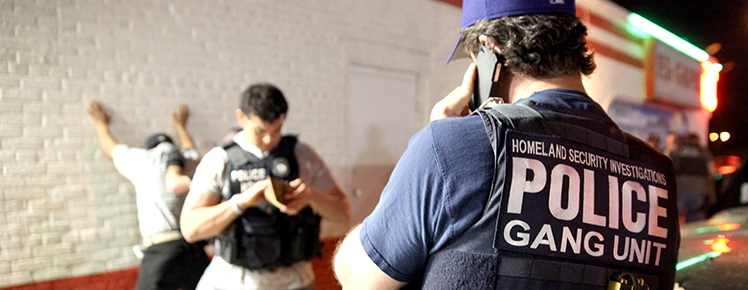WASHINGTON (ABC7) — U.S. Immigration and Customs Enforcement Officials are revealing details of a massive anti-gang operation that’s resulted in 1,378 arrests nationwide.
The six week long operation, which began March 26th, targeted violent criminal street gangs in the DC metro area, San Antonio, San Diego, and Newark.
“The primary purpose of the operation was to identify, arrest, and prosecute gang members and associates who threaten our communities,” Thomas Homan, ICE’s Acting Director told reporters.
The operation, called “Project New Dawn” was led by ICE’s Homeland Security Investigations section, known as HCI.
In the DC area alone, agents arrested 52 people, including 29 members of the El Salvador-controlled MS-13 gang.
“Nearly 1100 were arrested on federal or state criminal charges, including murder, assault and other crimes of violence,” says DHS Deputy Executive Associate Director Derek Benner.
Authorities arrested 21 people on murder related charges, and seven for rape and sexual assault charges.
Others face drug trafficking, weapons smuggling, human smuggling, sex trafficking, and racketeering charges.
Police say more than 1000 of those arrested had gang affiliations: connections to MS-13, and the Crips, Bloods, and the Surenos street gangs.
“Let me be clear that these violent criminal street gangs are the biggest threat facing our communities,” Homan says.
DC-based HSI agents arrested eleven MS-13 gang members in April at a home in Falls Church, police say.
Ten of those actions were ‘administrative arrests’, for immigation violations, the eleventh was a criminal arrest.
Investigators say federal agents and Fairfax County Police were keeping the home under surveillance because of reports about alleged sex trafficking.
“Our goal at the end of the day is to arrest, prosecute, imprison, deport and remove trans-national gang members as well as to supress violence, and prosecute crimial enterprises,” Benner says.
ICE says during the operation, officers seized 238 guns and $492,000 in cash.
But the agency also revealed a troubling trend.
Investigators in the San Diego area found street gangs are bucking the idea of turf or territory, and instead, are acting in concert, with different groups using each other’s expertise to maximize illegal profits.
“One gang, they specialize in narcotics smuggling, one may specialize in weapons trafficking,” Benner explains. “They’re using each other in this particular case, to further their own enterprises.”
Authorities say of those arrested, 933 are U.S. citizens, and 445 are foreign nationals from Central America, South America, Asia, Africa, Europe, and the Caribbean.
ICE’s Acting Director says the notion of sanctuary cities, where local authorities don’t cooperate with, or take part in ICE operations, is making these investigations more difficult.
“One officer can make (an) arrest inside the jail, turn him over to us, we can remove that person from the country,” Homan says. “When they get released without our attention, they’re back on the streets.”
He says after an initial arrest, 30 to 40 percent of gang-related suspects are repeat offenders.
Some of those in custody face federal re-entry charges, for returning to the U.S. after they were kicked out of the country for immigration or criminal violations.
ICE officials say this is not over, that there will be more operations like this in the future.
“We are not done,” Homan says. “We have a laser focus on these groups, and we will continue to actively pursue them, wherever they are in the United States.”
*** In 2016, ICE had a similar success. 
WASHINGTON — A five-week operation, dubbed Project Shadowfire, netted 1,133 arrests, including more than 900 transnational criminal gang members and others associated with transnational criminal activity, like drug trafficking, human smuggling and sex trafficking, murder and racketeering. The operation was led by U.S. Immigration and Customs Enforcement’s (ICE) Homeland Security Investigations (HSI) and concluded March 21.
“This operation is the latest example of ICE’s ongoing efforts, begun more than a decade ago under Operation Community Shield, to target violent gang members and their associates, to eradicate the violence they inflict upon our communities and to stop the cash flow to transnational organized crime groups operating overseas,” said ICE Director Sarah R. Saldaña.Since the inception of Operation Community Shield in February 2005, HSI special agents, working in conjunction with federal, state and local law enforcement agencies, have made more than 40,000 gang-related arrests and seized more than 8,000 firearms.
Project Shadowfire was a surge operation conducted under Operation Community Shield, and led by the HSI National Gang Unit. Between Feb. 15 and March 21, HSI special agents worked with numerous state, local and federal law enforcement partners, including ICE’s Enforcement and Removal Operations (ERO), to apprehend individuals from various gangs.
Most of the individuals arrested during Project Shadowfire were U.S. citizens, but 239 foreign nationals from 13 countries in Central America, Asia, Europe and the Caribbean were also arrested. Of the 1,133 arrests, 915 were gang members and associates, 1,001 were charged with criminal offenses and 132 were arrested administratively for immigration violations.
The majority of arrestees were affiliated with gangs like MS-13, Sureños, Norteños, Bloods and several prison-based gangs. Enforcement actions occurred around the country, with the greatest activity taking place in the Los Angeles, San Juan, Atlanta, San Francisco, Houston, and El Paso areas.
The National Gang Unit oversees HSI’s expansive transnational gang portfolio and enables special agents to bring the fight to these criminal enterprises through the development of uniform enforcement and intelligence-sharing strategies.
Recent National Gang Unit-led operations include: Southern Tempest in 2011, targeting gangs affiliated with drug trafficking; Project Nefarious in 2012, targeting gangs involved in human smuggling and trafficking; Project Southbound in 2014, targeting the Sureños, the fasting growing transnational gang in the U.S., and Project Wildfire in 2015, the largest gang surge conducted by HSI to date.
Additionally, for the past three years, ICE has held an anti-gang conference with the U.S. Department of State in Mexico City to provide training and capacity building for international law enforcement officers to combat and prevent gang activities.




